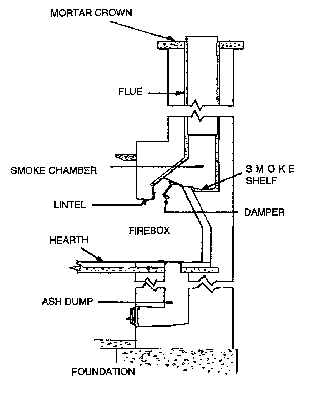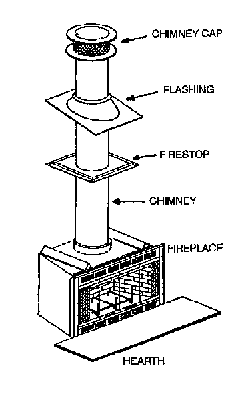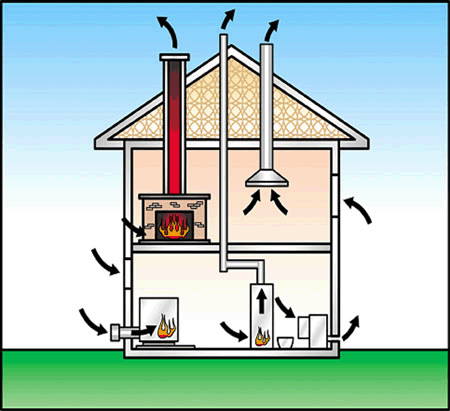
![]()
Anatomy of Your Fireplace
When most people think of chimneys, they think of fireplaces. Memories of cold winter evenings, relaxed and cozy in front of a crackling fire are hard to beat, and the ability of an open fire to soothe the wild beast within us all is legendary. Since the dawn of time, humans have gathered around the open fire for a sense of safety and community, and the fireplace is still the focus of family living in many homes, especially around the holidays.
But in spite of all the glowing aesthetics, there are some practical considerations. When you're dealing with an element as capricious and potentially dangerous as fire, knowledge really is power, so please read on to learn how to make your fireplace both safer and more enjoyable.
Let's start with a quick anatomy lesson, and a brief explanation of commonly used terms:


Fireplaces come in two general types, masonry fireplaces built entirely of bricks, blocks or stone and mortar, and factory built fireplaces consisting of a lightweight metal firebox and a metal chimney. (There are a few hybrids too, the most common being a heavy metal firebox and smoke chamber coupled to a regular brick chimney). To figure out which you have will take only a moment of detective work on your part.
A masonry fireplace has a firebox built of individual generally yellowish firebrick, a brick chimney above the roof, and if you look up past the damper you will see a roughly pyramid shaped affair also built of brick. A prefab fireplace generally has a firebox of cast refractory panels, and usually some metal is visible in the room all around the firebox. If you look up past the damper you will see a round metal chimney. And above the roof is more round metal chimney, sometimes surrounded by a simulated brick housing.
Although basically similar, there are some important differences. We have provided areas with some special considerations for masonry or prefabricated fireplaces that you can jump directly to by clicking the appropriate name.
Masonry Fireplace: Some Special Considerations
Masonry fireplaces, built entirely of bricks, blocks or stone and mortar, are massive structures often weighing between 6 and 7 tons! They are aesthetically pleasing, long lasting, and add real value to your home. With a little care and periodic maintenance they can literally give you a lifetime of enjoyment.
Masonry fireplaces require an extensive footing capable of supporting their great bulk, and if not provided with one will often shift and crack, allowing the fire to escape to nearby combustibles. You should always keep an eye out for any signs of settling or movement. Just inside the firebox, where the facing material meets the firebrick, is one weak spot where this settling is often first apparent. Keeping downspouts directed away from the fireplace and careful sloping of the ground around the fireplace to be sure water runs away from the structure can keep settling problems to a minimum.
Although masonry is quite durable, and in fact is often seen as indestructible, this is certainly not the case, especially for a chimney. While the rest of the brick on the house is somewhat protected by the eave, the poor chimney is sticking up like a flagpole, exposed to every raindrop and freeze/thaw cycle. A quality chimney cover, keeping the crown in good repair, and a waterproofing treatment, are money well spent to avoid expensive repairs or rebuilding. See the section on waterproofing for a more detailed explanation.
The firebox of course takes the brunt of the fire's heat and it requires some special attention. The firebrick can take the heat pretty well, but the joints will fail in time from the constant expansion and contraction. In addition, refractory mortar is specified and seldome used. In a fireplace without a chimney cover, the rain water will also pool on the smoke shelf, mix with the soot behind the damper, and form an acidic slurry that seeps into the fireback destroying the mortar joints. These joints must be kept in good repair with a high temperature refractory mortar to ensure the fire is contained.
The tile liners used in most masonry fireplaces are just fine as long as the fireplace is properly maintained and not exposed to chimney fires. One good chimney fire will usually crack these tiles, rendering them incapable of performing their intended function. The general rule of thumb is that a masonry fireplace should be cleaned before 1/4" of soot accumulates. If you ever do experience a chimney fire, it is very important to have the chimney swept and inspected before it is used again.
Unlike prefabricated fireplaces which are factory engineered products, a masonry fireplace is built on site brick by brick, giving the mason ultimate control of the final product. This results in a wide range of masonry fireplaces available, from long lasting, heat producing beauties, to smoky pits that crumble in a relatively short time. Most masonry fireplaces that chimney sweeps encounter, although far from perfect, can, with a little tender loving care, and carefully considered maintenance procedures, provide you with many peaceful, relaxing hours in an otherwise often hectic world.
Prefabricated Fireplaces
Factory built, or prefabricated fireplaces, are relative newcomers to the fireplace scene, commonly available only for the last 25 years or so. Unlike traditional site-built masonry fireplaces, most factory built fireplaces are made of metal, and come from the factory as complete units with a firebox, a specific chimney system, and all miscellaneous parts. With proper installation and maintenance, they can give years of service, but there are some special considerations owners of these systems should be aware of:
Is your chimney not working correctly? Does it seem like you have tried everything and nothing helps? Perhaps the problem lies in your Chimney Physics!

At first, this might sound complicated. But really it isn't. Here are some simple scientific fundamentals to explain how and why a chimney works—or maybe why it doesn't. This brochure is designed to make it easy to follow along with the procedures a knowledgeable CSIA Certified Chimney Sweep® will use to diagnose smoking or odor problems with your chimney.
Your House as a System
Even though you can't see it, the air in your house is constantly in motion. In general, airflow tries to flow out of your house in the upper parts and make up air tries to flow into your house in the lower parts of your house. Thinking of your house as a system makes it easy to understand the reasons for that airflow. The actual flow of air into and out of any home is influenced by a number of constantly changing factors, including: stack effect; wind loading; interior mechanical systems and fuel-burning appliances such as furnaces, fireplaces, wood stoves and water heaters.
Homes built in the past 25 years, and older homes that have been renovated, have been made more airtight. This makes it much more difficult for makeup air to enter the home. As the saying goes, "hot air rises", and so does the warm air in your home.
When the warm air rises to the upper areas it's called the stack effect. That trapped air creates a pressurized area and forces its way out—through even very small openings such as recessed light fixtures and window frames. At the same time replacement air is trying to enter in the lower part of the building to make up for the escaping air.
Somewhere in your house, amid all this airflow, is something called the Neutral Pressure Plane (NPP). Above this theoretical plane, the air pressure is slightly positive compared to the outdoor air pressure and is trying to force its way out of the house. Below the plane, it is slightly negative and the house is trying to draw air in. The location of the NPP can constantly change in response to changing conditions.
All of the factors that affect airflow in the house also influence the level of the Neutral Pressure Plane.
Anytime a fireplace or fuel-fired heating appliance (except direct vent) is below the plane, air will tend to flow into the house through the chimney or vent. A common example of this is found in homes with two fireplaces, one below the other. As the upper level fireplace uses air for combustion and chimney flow, it depressurizes that level slightly causing air to flow upwards from the lower level. Since the lower level fireplace is below the NPP, it draws air into the basement through the chimney. Unfortunately, since those two flues generally exit the chimney close to each other, the makeup air can contain some smoke from the fireplace above and it can pick up unpleasant chimney odors as it passes down the chimney flue.
Wind-loading is the effect on interior house pressures caused by the wind. When wind strikes a building, it creates high pressure on the side that it hits and low pressure on the downwind side. Any open windows or doors on the windward side will help to pressurize the house, increasing chimney draft. However, openings on the downwind (leeward) side will depressurize the house and increase the likeliness of backdrafting from chimneys or vents. Backdrafting is a reversal of the airflow in which the smoke is coming into the house instead of going up the chimney.
Interior mechanical devices such as clothes dryers, kitchen fans, bathroom fans, attic fans and central vacuums can also create depressurization by removing large volumes of air from the house. The result is often negative pressure in the area of a fireplace, woodstove, or other fuel-fired heating appliance making it increasingly difficult for natural draft chimneys to function as intended.
Another mechanical system that commonly removes air from the house is a forced-air furnace. Many such systems are out-of-balance due to leaks in the ducts. Leaky supply ducts cause air to be blown into the attic or crawlspace. Leaky return ducts draw air from the basement or other areas they pass through.
Furnaces, water-heaters, fireplaces and woodstoves are examples of fuel-burning appliances that require large volumes of air for combustion. Unless they are specifically equipped to draw air in from outside the house, such as direct vent appliances, operating them can reduce the inside air pressure. There are a variety of mechanical devices on the market that help provide the necessary make up air to balance the air pressure needs of your house system.
Draft and Flow
Many experienced chimney professionals use the similarities between water and air to explain the way your chimney works. Although most people don't realize it, the air moving up your chimney works under the same set of physical principles as water flowing in a hose or pipe.
When a fireplace chimney is full of hot air, it actually pulls air through the firebox. This pulling effect is called draft and it corresponds to the amount of pressure in a water hose—the only difference is that the air pressure is negative and the water pressure is positive (think of using a straw to drink with instead of to blow bubbles). Thus, a chimney is called a negative pressure system. Increasing the draft in your chimney is like opening the faucet wider on the hose. The simplest way to increase the draft in your chimney is to burn the fire hotter—hotter air is lighter, so it has more pull. Another way to get more draft is to increase the height of your chimney—except when the chimney is already so tall that frictional forces negate the effect of the extra height.
Given the same amount of pressure, a larger pipe can obviously carry a greater volume of water than a smaller one. The same is true for chimneys—with the same amount of draft (pressure) a larger flue will exhaust more smoke from your fireplace than a smaller one. But just as a water hose can be kinked or plugged, the airflow in your chimney can have a restriction that slows down the smoke flowing up the chimney. Some of the reasons for poor flow in a chimney are: excessive creosote deposits; closed or plugged dampers; improper construction; structural damage or even a dirty chimney cap. In fact, having a plugged-up chimney cap at the end of your chimney is just like having a closed nozzle at the end of a hose—you just can't get any airflow through the chimney. Your CSIA Certified Chimney Sweep can evaluate your chimney and recommend any corrective action to ensure that it is capable of the proper draft and flow.
Why fireplaces work, and how best to build them, has been a topic of hot debate literally for centuries. From the first stone rings stacked around the campfire, to the modern factory built fireplaces with carefully engineered dimensions, there has been a steady evolution of design parameters to make sure they draw well and cast as much heat as possible. Most of this evolution has been by trial and error, and some designs work much better than others.
Simply put, fireplaces work mainly because hot air rises. When you start a fire, the air inside the chimney becomes warmer and less dense than the air outside the chimney, and consequently it starts to rise. As the warm air rises, cooler air from the room flows into the firebox, fanning the fire, creating more heat in an ongoing cycle. There are also some pressure differentials produced as wind moves across the top of your chimney.
There must be at least 100 reasons why your fireplace may not function properly. We will try to cover some of the basics here starting with the easy obvious solutions and working towards the more arcane. Please bear in mind this is a very simplified list of the more common reasons that fireplaces don't work A true understanding of fireplaces requires extensive knowledge of air flow patterns, pressure differentials, and actual fireplace construction techniques. If the information provided here does not help you solve the problem with your fireplace, consider hiring an experienced, certified chimney sweep in your area. Often the problem is obvious to someone with enough experience once they can acutally look over the entire situation.
All above information comes from the CSIA website.